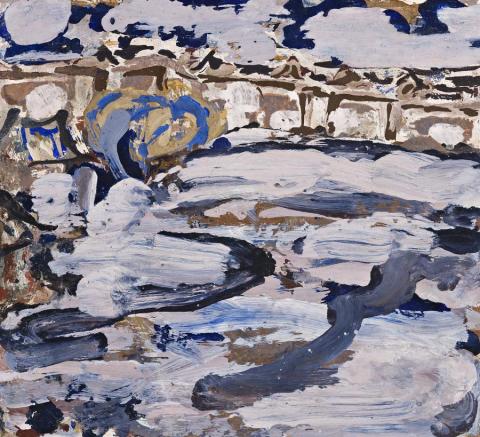RIVER AT HANGCHOW, 1945-47
Ian Fairweather
gouache on paper on cardboard
24.0 x 26.0 cm
Redfern Gallery, London
Mrs Wertheim, acquired from the above 1948
Thence by descent
Blue Boy Gallery, Melbourne
Private collection, Melbourne, acquired from the above 1978
Paintings by Ian Fairweather, Redfern Gallery, London, 28 October - 20 November 1948, cat. 13 (label attached verso)
Bail, M., Fairweather, Murdoch Books, Sydney, 2009 edition, cat. 63, p. 82, pl. 57 (illus.)
River at Hangchow, 1945–47, gouache on cardboard, 23.0 x 25.5 cm, Private collection, Sydney
The legendary pink city of Hangchow appealed greatly to Ian Fairweather and often appeared throughout his art. As Murray Bail has pointed out, the artist long believed in the Chinese proverb 'in heaven there is paradise; on earth Soochow and Hangchow.'1 For over a thousand years Hangchow has been one of the most renowned cities of China, known for its beautiful scenery and West Lake. Even as early as the thirteen century the Venetian adventurer Marco Polo had described it as one of the finest and noblest in the world. This blend of natural and man-made beauty is captured in Fairweather's paintings of Hangchow, memorably in Temple, West Lake, Hangchow 1936, in the collection of Mr James Fairfax, and (River, Hangchow) 1941 in the National Gallery of Australia, Canberra. Hangchow is also famous for its tidal bore, the largest in the world. The bore races up the Qiantang River through Hangchow at heights of over twelve metres. This tidal phenomenon is characterised by its intense turbulence and powerful roar, which can be heard from far away.
When Ian Fairweather left China for the last time in 1936, he took with him many sketches and visually rich memories. Over the following years he returned to these, producing a number of splendid paintings on Chinese subjects engagingly referred to by Bail as 'serene remembrances'.2
Among these was the anything but serene River at Hangchow. One of a number painted in Melbourne during 1945 to 1947, it was included in his 1948 exhibition at London's Redfern Gallery. Oriental calm momentarily gave way to expressionist verve as Fairweather captured the drama of the tidal rush. The overall effect is almost abstract, the figuration of background buildings being an anchor for the eye. In its play between abstract and the figurative, it is in many ways a harbinger of future stylistic developments. The subject had so great an appeal that Fairweather painted a second version, similar in style and size.
1. Bail, M., Fairweather, Murdoch Books, Sydney, 2009, p. 51
2. Ibid., p. 71
DAVID THOMAS
